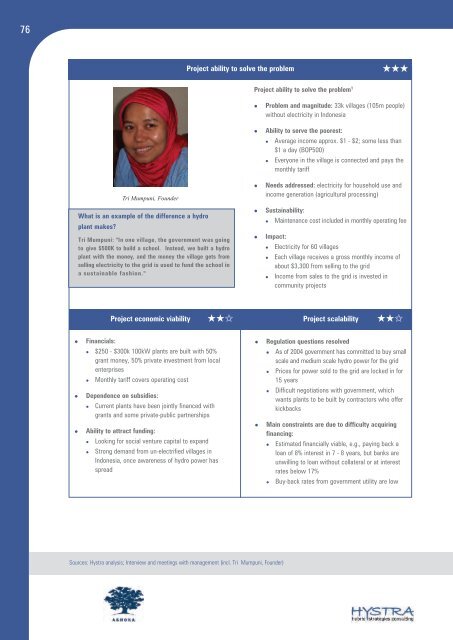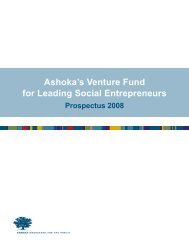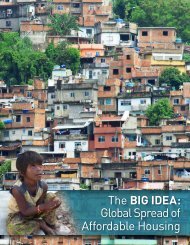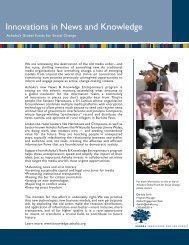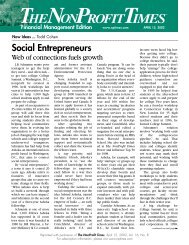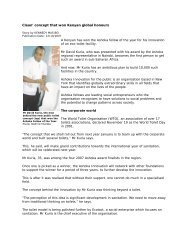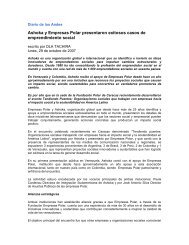Access to Energy for the Base of the - Ashoka
Access to Energy for the Base of the - Ashoka
Access to Energy for the Base of the - Ashoka
You also want an ePaper? Increase the reach of your titles
YUMPU automatically turns print PDFs into web optimized ePapers that Google loves.
76<br />
� Financials:<br />
Tri Mumpuni, Founder<br />
What is an example <strong>of</strong> <strong>the</strong> difference a hydro<br />
plant makes?<br />
Tri Mumpuni: "In one village, <strong>the</strong> government was going<br />
<strong>to</strong> give $500K <strong>to</strong> build a school. Instead, we built a hydro<br />
plant with <strong>the</strong> money, and <strong>the</strong> money <strong>the</strong> village gets from<br />
selling electricity <strong>to</strong> <strong>the</strong> grid is used <strong>to</strong> fund <strong>the</strong> school in<br />
a sustainable fashion."<br />
Project ability <strong>to</strong> solve <strong>the</strong> problem<br />
Project ability <strong>to</strong> solve <strong>the</strong> problem 1<br />
� Problem and magnitude: 33k villages (105m people)<br />
without electricity in Indonesia<br />
� Ability <strong>to</strong> serve <strong>the</strong> poorest:<br />
� Average income approx. $1 - $2; some less than<br />
$1 a day (BOP500)<br />
� Everyone in <strong>the</strong> village is connected and pays <strong>the</strong><br />
monthly tariff<br />
� Needs addressed: electricity <strong>for</strong> household use and<br />
income generation (agricultural processing)<br />
� Sustainability:<br />
� Maintenance cost included in monthly operating fee<br />
� Impact:<br />
� Electricity <strong>for</strong> 60 villages<br />
� Each village receives a gross monthly income <strong>of</strong><br />
about $3,300 from selling <strong>to</strong> <strong>the</strong> grid<br />
� Income from sales <strong>to</strong> <strong>the</strong> grid is invested in<br />
community projects<br />
Project economic viability Project scalability<br />
� $250 - $300k 100kW plants are built with 50%<br />
grant money, 50% private investment from local<br />
enterprises<br />
� Monthly tariff covers operating cost<br />
� Dependence on subsidies:<br />
� Current plants have been jointly financed with<br />
grants and some private-public partnerships<br />
� Ability <strong>to</strong> attract funding:<br />
� Looking <strong>for</strong> social venture capital <strong>to</strong> expand<br />
� Strong demand from un-electrified villages in<br />
Indonesia, once awareness <strong>of</strong> hydro power has<br />
spread<br />
Sources: Hystra analysis; Interview and meetings with management (incl. Tri Mumpuni, Founder)<br />
★★★<br />
★★✩ ★★✩<br />
� Regulation questions resolved<br />
�� As <strong>of</strong> 2004 government has committed <strong>to</strong> buy small<br />
scale and medium scale hydro power <strong>for</strong> <strong>the</strong> grid<br />
� Prices <strong>for</strong> power sold <strong>to</strong> <strong>the</strong> grid are locked in <strong>for</strong><br />
15 years<br />
� Difficult negotiations with government, which<br />
wants plants <strong>to</strong> be built by contrac<strong>to</strong>rs who <strong>of</strong>fer<br />
kickbacks<br />
� Main constraints are due <strong>to</strong> difficulty acquiring<br />
financing:<br />
�� Estimated financially viable, e.g., paying back a<br />
loan <strong>of</strong> 8% interest in 7 - 8 years, but banks are<br />
unwilling <strong>to</strong> loan without collateral or at interest<br />
rates below 17%<br />
� Buy-back rates from government utility are low


